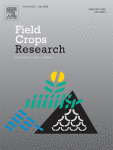Ver ítem
- xmlui.general.dspace_homeCentros Regionales y EEAsCentro Regional Buenos Aires SurEEA BalcarceArtículos científicosxmlui.ArtifactBrowser.ItemViewer.trail
- Inicio
- Centros Regionales y EEAs
- Centro Regional Buenos Aires Sur
- EEA Balcarce
- Artículos científicos
- Ver ítem
Nitrogen deficiency in maize fields of the Southern Pampas does not affect kernel number but reduces weight per kernel
Resumen
Nitrogen (N) requirement of maize has been increasing over the past decades, but there has been a lack ofadjustment in fertilization management practices across different regions in Argentina. The higher N requirementin modern hybrids is associated with a higher post-flowering N accumulation. Additionally, soil fertility in theArgentina Pampas has consistently decreased in recent years. Whether the effects of N deficiency are expressed inthe
[ver mas...]
Nitrogen (N) requirement of maize has been increasing over the past decades, but there has been a lack ofadjustment in fertilization management practices across different regions in Argentina. The higher N requirementin modern hybrids is associated with a higher post-flowering N accumulation. Additionally, soil fertility in theArgentina Pampas has consistently decreased in recent years. Whether the effects of N deficiency are expressed inthe post-flowering period is still unclear at field level. The objective of this work was to quantify the yieldreduction attributed to N deficiency and to identify the physiological basis of this effect at the field level fortypical high-tech farms across the south-eastern Pampas of Argentina. Nineteen experiments were conductedduring the 2020/2021 growing season in the south-eastern Pampas, evaluating two N managements i) Farmers’N level; ii) High N input. Results showed that the additional N input increased grain yield by an average of 6.4%(average grain yield difference of 712 kg ha− 1). Weight per kernel was the only yield component that respondedto N fertilization. Farmers’ N management did not affect N accumulation or growth-related variables such as leafarea index, green leaves per plant, PAR interception, nitrogen sufficiency index until flowering, but the farmers’N level reduced these variables during the grain filling period leading to differences in aerial biomass and Naccumulated at physiological maturity. Farmers’ N level led to decreased post-flowering N uptake during grainfilling period, which reduced the photosynthetic capacity of the canopy. These findings suggest that N management strategies and models need to be reviewed for high-tech maize systems.
[Cerrar]

Autor
Moisés Domínguez, Clara;
Andrade, Fernando Hector;
Monzón, Juan Pablo;
Reussi Calvo, Nahuel Ignacio;
Cerrudo, Aníbal Alejandro;
Fuente
Field Crops Research 312 : 109394 (May 2024)
Fecha
2024-05
Editorial
Elsevier
ISSN
0378-4290
Formato
pdf
Tipo de documento
artículo
Palabras Claves
Derechos de acceso
Restringido
 Excepto donde se diga explicitamente, este item se publica bajo la siguiente descripción: Creative Commons Attribution-NonCommercial-ShareAlike 2.5 Unported (CC BY-NC-SA 2.5)
Excepto donde se diga explicitamente, este item se publica bajo la siguiente descripción: Creative Commons Attribution-NonCommercial-ShareAlike 2.5 Unported (CC BY-NC-SA 2.5)


